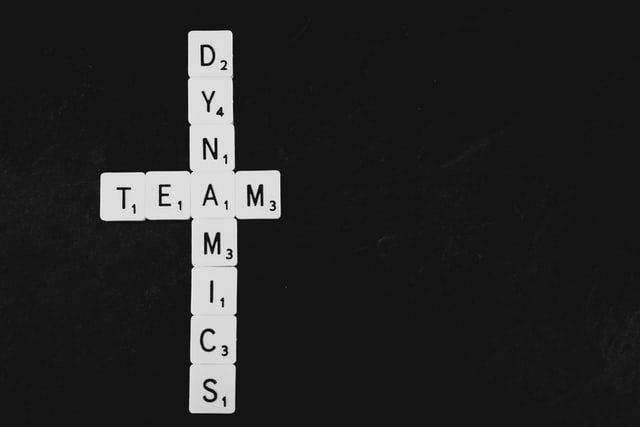It’s tempting to point the finger at a number of potential causes or some behavior when your team isn’t functioning effectively, but it all boils down to this one simple answer- team dynamics.
If your team has trouble making decisions and seems to battle itself at every critical point, it’s time to do some digging to find out whether or not everyone is on the same page.
Here are tips for behaviors of effective team dynamics.
Let’s dive right into it.
A key characteristic of team dynamics is a shared goal or project. When teams work together, it’s crucial everyone is clear on the direction or goal.
A popular method for goal-setting to practice is the acronym SMART. Effective goals should be Specific, Measurable, Attainable, Relevant and Time-bound.
2. Trust And Openness
Positive dynamics to have are an environment for every team member to feel safe sharing information and ideas without fear of punishment or embarrassment.
Trust opens the door to dialogue opening a path to better ideas and creative direction. Team members must also be able to trust that everyone will meet their deadlines and do their part of the work.
It’s leadership’s responsibility is to build accountability. Ask yourself “Do my team members trust me?”

3. Willing To Correct Mistakes
Success depends on results. To do so, track your work and be willing to change course if there are weaknesses in your results.
A successful team looks for opportunities and resources to learn from the situation and improve it. They don’t let past mistakes limit their future success.
Related: What Are Examples Of Effective Team Dynamics
4. Diversity And Inclusion
Leverage different thoughts and ideas from the group to progress with innovative and creative solutions.
If you find your team comes up with ideas unanimously, quickly and often, your team might be experiencing groupthink, which is death to creativity.
It’s important to encourage diversity within your team so it can settle on the best idea, not the easiest one.
In a cross-functional team, you may achieve diversity simply by mixing members from different departments with different skills and perspectives.
If you’re building a departmental team, you can achieve diversity in your hiring practices by expanding your recruiting sources to attract diversity in age, sex, ethnicity, and sexual identity.
5. Interdependence With A Sense Of Belonging
It’s essential that each individual on the team understand their value and responsibility. If your onboarding behavior is rushed or disorganized, you may miss this.
As team leader, establish this up front. Imagine how much more productive your team will be if each person has the sense of ownership for the work of others as they do for their own work.
It’s important for each person of a team to come together while collaborating on ideas and assistance. When a team is focused on fulfilling its purpose, members can work together performing their roles without keeping tabs on how much they give or take.
Related: Cog’s Ladder Easy Explained Including Its Stages
6. Consensus Decision Making
Having more people involved in decision making can be essential in your company to channel the creative power of multiple minds resulting in innovative and out-of-the-box solutions.
The key is consensus decision making which requires the right processes to be in place. A few strong personalities could dominate the discussion.
Avoid decisions by peer pressure. There will be times for members to compromise and come up with the best blend of an idea, as long as they don’t feel coerced.
7. Leadership Participates
Micro-managing stifles creativity and often undermines an employee’s sense of ownership, confidence and trust by encouraging a climate of fear.
Participative leaders practice stepping back to give members the space to work autonomously. Instead of controlling their group, they help by providing resources, guidance, and information.
This is understanding the difference between leadership and power.
What Are Examples Of Effective Team Dynamics CPR?
Team dynamics are an important aspect when helping to save a life. Accept all the help you can get to improve your chances in a critical time.
Resuscitation times are tense, which could lead to emotions getting out of hand between one another. So, it’s important for teams to remain calm and composed.
During a code, it’s common for teams to have many people around watching the rescuers performing their roles. If you yell/shout at someone, their ego can feel hurt and situations can deteriorate.
Let’s consider the following behaviors to keep in mind when you’re building or leading a team.
Related: Group Polarization – 11 Strategies To Avoid It (Backed By Science)
1. Roles And Responsibilities
- Without a clearly assigned role, multiple members may rush to do one thing and forget to do a different critical task, which might go unnoticed. Before you start a resuscitation, always assign a “clear role” to each individual on the team.
- For every team member, if you are given a task you don’t feel you’re competent enough at, it’s up to you to let the team leader know and ask for a different role. Do not take a new role by yourself.
- For example, if you have a shoulder dislocation problem, and your team lead asks you to perform compressions, let him know and ask for a different role.
This is known as “knowing your limitations“. Being aware of what you are capable of and what you are good or not good at.

2. Communication
- Clear language and polite manners for communication are the key for good team dynamics. Leadership to focus on being in control of his voice, so every team member doesn’t feel like they’re being bossed upon.
- It’s important for every team member to follow a closed loop communication process to prevent common errors in following orders effectively.
When a team leader orders you to “Load 1mg of adrenaline”, for effective communication, respond by saying “Am loading 1mg of adrenaline”.
- What if you think the team leader gave the wrong dosage and you know the right dose? You may talk politely to correct a colleague’s direction.
When you hear your team leader say “Give 0.5mg of epinephrine” during a cardiac arrest, you may say “I have heard an order of 0.5mg of epinephrine but i think the correct dose is 1mg.”
The team leader may respond by saying “Thank you, you are correct”. This is sharing knowledge/constructive criticism while maintaining respect.
- If you are a team member and you notice another member doesn’t perform his role effectively, you may suggest he correct it.
If someone’s compressions are slow, you may tell them “Let’s maintain a rate of 100-120/min”.
Related: Ways To Credible Leadership
3. Things To Avoid
- Do not push a colleague away and do his role if your colleague is not doing it well.
- Do not yell at other team members. Do not be mean or insulting to another member. Maintain respect with all communication.
- Do not get offended when you are corrected.
- Do not respond with an incomplete loop of communication to orders received. Instead repeat the entire order.
“OK”, “I’ll do it”, “Am on it”, “Got it”, etc. are poor communication skills.
Focus on being tactful and positive in dealing with team members. Effective communication is the process that can help encourage the team to stick together.
What Are Examples Of Effective Team Dynamics CPR Quizlet
1. Knowing Your Limitations
Leaders to be aware of others’ limitations. Team members to ask for
assistance early.
2. Constructive Intervention
Team member or team leader corrects actions.
3. Knowledge Sharing
Leaders ask frequently for observations and feedback.
4. Closed Loop Communication – Team Leader
Leadership to call members by name and make eye contact. Don’t assign rules until the team understands the instructions.
5. Closed Loop Communication – Team Member
Team member to confirm you understand the task by verbally acknowledging the task and let the team leader know when the task is complete.
6. Mutual Respect
All team members to display a professional attitude to other members. Leaders speak in a friendly, controlled voice and avoid shouting.
7. Debriefing
An opportunity for individuals of the team to identify why certain actions were taken.
The GRPI Model for Effective Teams – Easy Explained is an excellent resource for more examples.
What Are Effective Team Dynamics?
A proven way to build a successful business team is to:
- Assemble a group with a stellar mix of knowledge and expertise.
- Get to know the strengths and personalities of your group to create successful team dynamics.
- If necessary, seek out positive new people to strengthen your lineup.
Positive team dynamics occur when:
- The team trusts each other
- Work collectively
- Hold each other accountable
When a team has a positive dynamic, its members are more successful and there is less chance of negative conflict.
Poor team dynamics include:
- People whose behavior disrupts work flow and results in wrong choices
- Poor decision-making or no decision-making at all
Negative team dynamics leave the team more vulnerable to conflicts.
Examples Of Team Dynamics In The Workplace
Research has concluded the best teams include team members who listen to one another and show sensitivity and respect.
Also, studies show working in teams, rather than alone on a project, is more productive with greater job satisfaction.
The following are some real (anonymised) examples of team dynamics – the symptoms, causes, and how problems were overcome.
- There was increasing distrust between the management of two organisations who were collaborating on an international project, potentially escalating to legal action.
Solution: A Team Health Check revealed that each organisation tended to interpret the other’s actions in a negative way – i.e. a “team island” or in/out group problem.
A group workshop built greater understanding of each other’s motivations and enabled them to find positive ways of working towards the shared goal.
- A new member of a team was causing friction with established members. As a result, they tended to resist any changes she tried to introduce.
Solution: A Team Health Check revealed a fundamental misunderstanding of the role of the new person. She had been guided by her job description, which gave her a wider set of responsibilities than the team expected her to have.
The misunderstanding was cleared up in a constructive team building workshop, and the team members’ roles and responsibilities were clarified and agreed.
- A member had an affair with the team boss. This destroyed trust and communication in the group.
Solution: A Team Health Check allowed support to everyone to express their feelings confidentially to someone independent.
Then, a series of workshops gradually enabled them to express their concerns with transparency to each other, come to terms with what had happened, and agree how they accomplished overcoming the problems of distrust.
There is help in learning how to build great team dynamics. Read TOP Team Building Consulting Firms You Should Know.

Factors That Contribute To Team Dynamics
1. Be an Effective Leader
A successful manager must also be an effective team leader who gets to know employees well enough to pair them successfully for projects.
- Find out if magic exists among your teams by asking previous supervisors or colleagues about your team members to gain insight into their work ethics, skills and personality traits.
- Looking at past performance reviews also helps gather insights about how individual team members can cohesively work together toward a common goal.
- Also encourage team members to complete a background and interest survey.
Make the survey half work-related and the other half personal. Include career goals, constructive ways to improve a team, previous business experience, along with favorite vacation spots, pets and hobbies.
Related: Be, Do, Have Model Simplified – 12 Facts To Know
2. Meet with Your Team
- Set up a meeting to review and discuss the surveys. A manager can improve communication by providing his or her own answers.
- Celebrate occasions with your team to create a positive culture of inclusion.
During those celebrations, update the team on company milestones and allow them to share personal achievements.
- Give your team space and allow them to ask questions of each other encouraging positive communication, harmony and building team performance.
3. Address Issues Early On
“It’s important to address as many of the issues that arise together as a team, rather than singling people out,” says Ashira Prossack, a millennial and Gen Z engagement expert who writes about leadership trends for Forbes.
Here are some ways to address certain negative dynamics early:
- Group weaknesses like social loafing, for example, is where one member of the team doesn’t act, thinking another member will pick up the slack.
Being vigilant about this will help you avoid over-rewarding the slacker and under-rewarding the team member who hustles.
- They are more likely to take risky positions because responsibility is defused.
Individuals are less likely to take a risky position on a project because if something goes wrong, that individual must shoulder all the responsibility.
Read more in Integrated Leadership: 7 Ideas To Be A Better Leader.
Communication, empathy and mutual understanding all create a productive environment for your team dynamics, resulting in increased performance, accountability and job satisfaction.
By understanding each other’s work styles, strengths and attributes, work stops becoming laborious and becomes a collective goal or project.
We hope you’ve found this article valuable to the dynamics in your team ✅ and we invite you to leave a comment or share ✅ with a friend or colleague to benefit their dynamics.
Related Posts
Why Life Sucks and 13 Expert Strategies For A Turnaround
